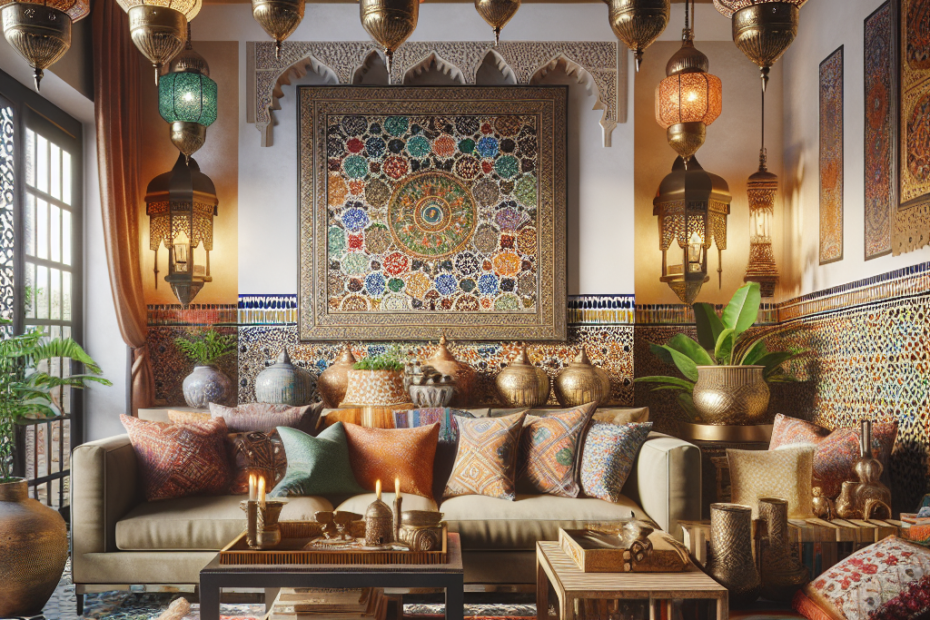Moroccan Design: Bold Colors and Patterns for Your Home
Moroccan design is a unique style that combines bold colors and intricate patterns to create an exotic, vibrant look. This style has become increasingly popular in homes around the world as people look for ways to add a touch of culture and beauty to their spaces. Let’s take a closer look at what makes Moroccan design so special and how you can incorporate it into your home.
An Overview of Moroccan Design
Moroccan design is characterized by its use of vivid colors, elaborate patterns, and luxurious textures. This style is heavily influenced by the rich culture and history of Morocco, blending Islamic, Arab, and Berber traditions. Elements such as mosaic tiles, detailed woodwork, and ornate textiles are commonly found in Moroccan interiors.
| Element | Description |
|---|---|
| Color Palette | Bold colors like turquoise, red, saffron, and cobalt blue. |
| Patterns | Geometric shapes, floral designs, and intricate tilework. |
| Materials | Natural textiles, metal lanterns, and lush rugs. |
Key Elements of Moroccan Design
Bold Colors
The use of bold and vibrant colors is a hallmark of Moroccan design. Colors like rich reds, bright blues, earthy yellows, and lush greens are often used to create a stunning visual impact. These colors are not just for the walls but can also be found in furniture, rugs, and even ceilings.
Intricate Patterns
Moroccan design employs a variety of intricate patterns. From geometric shapes to detailed floral designs, these patterns are often seen on tiles, textiles, and even furniture. The detailed mosaics, known as zellige, are particularly popular in Moroccan interiors.
Luxurious Textures
Textures play a vital role in Moroccan design. Plush rugs, soft cushions, and intricate metalwork create a sense of luxury and comfort. The combination of different textures adds depth and interest to the space.
Historical Roots of Moroccan Design
Moroccan design has a rich history that dates back centuries. It has been influenced by various cultures, including Islamic, Arab, and Berber traditions. This blend of influences has resulted in a style that is both diverse and unique. Detailed woodwork, mosaic tiles, and ornate textiles were historically used to decorate palaces and mosques, showcasing the craftsmanship of Moroccan artisans.
Benefits of Moroccan Design
Incorporating Moroccan design into your home can offer many benefits:
- Vibrant Atmosphere: The bold colors and intricate patterns create a lively and energetic space.
- Cultural Richness: Moroccan design adds a touch of cultural heritage and history to your home.
- Versatility: This style can be adapted to both modern and traditional interiors.
- Personal Expression: Moroccan design allows for creativity and personal expression through the use of different elements and accessories.
Step-by-Step Guide to Creating a Moroccan-Inspired Room
- Select a Color Palette: Start with a bold color palette that includes rich hues like red, blue, and yellow.
- Incorporate Patterns: Use patterned tiles, rugs, and textiles to add visual interest and depth.
- Add Textures: Combine different textures such as plush rugs, metal lanterns, and soft cushions.
- Accessorize: Use accessories like Moroccan lanterns, ornate mirrors, and handcrafted pottery to complete the look.
- Mix and Match: Don’t be afraid to mix different elements and styles to create a unique and personalized space.
Modern Applications of Moroccan Design
While Moroccan design has deep historical roots, it can also be adapted to modern homes. Contemporary Moroccan-inspired interiors often feature a combination of traditional elements and modern touches. For instance, a modern living room might include a Moroccan-style rug, a sleek metal lantern, and minimalist furniture. This blend of old and new creates a stylish and inviting space that honors the traditions of Moroccan design while keeping it relevant to today’s aesthetic preferences.
Statistics show that the popularity of Moroccan design is on the rise. According to a study by Home Decor Trends (source: Home Decor Trends), searches for “Moroccan design” have increased by 30% in the past two years. This indicates a growing interest in this vibrant and unique style.
Key Takeaways
- Moroccan design is known for its bold colors, intricate patterns, and luxurious textures.
- The style is influenced by Islamic, Arab, and Berber traditions.
- Incorporating Moroccan design can add vibrancy, cultural richness, and versatility to your home.
- Modern applications of Moroccan design blend traditional elements with contemporary touches.
- There is growing interest in Moroccan design, with a 30% increase in searches over the past two years.
FAQ
- What colors are commonly used in Moroccan design?
- Colors like rich reds, bright blues, earthy yellows, and lush greens are commonly used in Moroccan design to create a vibrant atmosphere.
- How can I incorporate Moroccan patterns into my home?
- You can incorporate Moroccan patterns through tiles, rugs, textiles, and even furniture. Look for geometric shapes and floral designs.
- What materials are often used in Moroccan interiors?
- Moroccan interiors often feature natural textiles, detailed woodwork, metal lanterns, and plush rugs.
- Can Moroccan design be used in modern homes?
- Yes, Moroccan design can be blended with modern elements to create a stylish and inviting space. This often includes a mix of traditional patterns and contemporary furniture.
- Why is Moroccan design becoming more popular?
- Moroccan design is becoming more popular due to its vibrant colors, intricate patterns, and the cultural richness it brings to a space. Increased interest in global designs has also contributed to its popularity.
